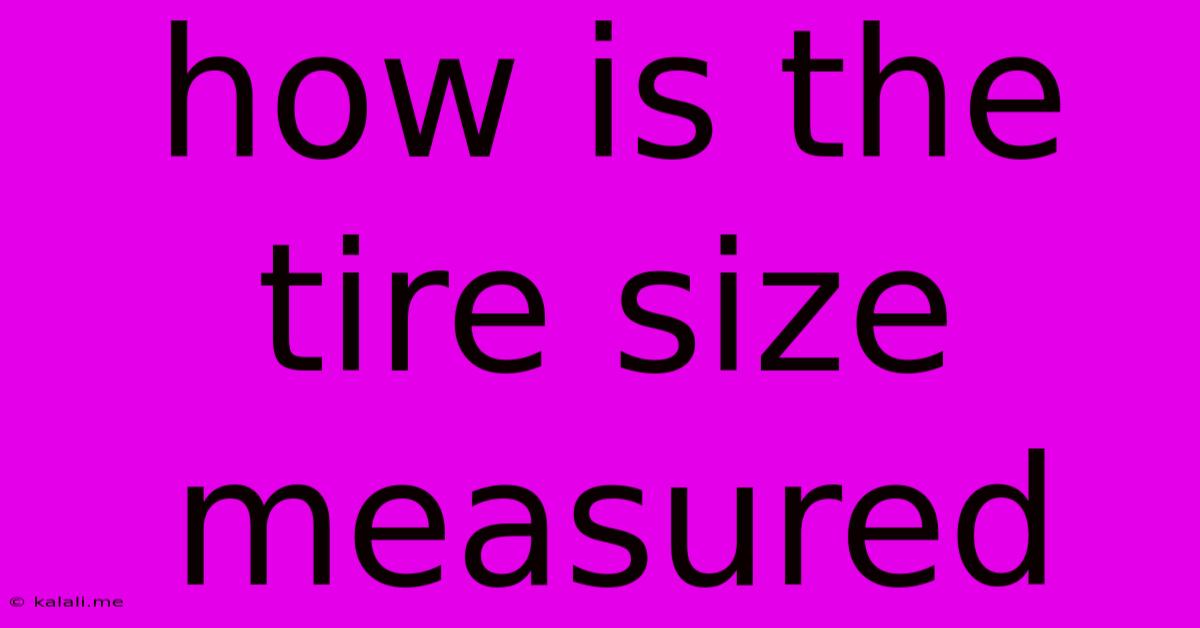How Is The Tire Size Measured
Kalali
Jun 03, 2025 · 3 min read

Table of Contents
Decoding Tire Sizes: A Comprehensive Guide
Understanding tire sizes might seem daunting at first, but it's simpler than you think. Knowing how to read tire size codes is crucial for maintaining your vehicle's performance and safety. This guide will break down the process, explaining the numbers, letters, and what they all mean. By the end, you'll be able to confidently decipher any tire size designation.
What Does a Tire Size Mean?
Tire size is expressed in a series of numbers and letters, each representing a specific aspect of the tire's dimensions and characteristics. This information is vital for choosing the correct replacement tires and ensuring optimal performance and safety for your vehicle. Incorrect tire sizes can affect your vehicle's handling, fuel economy, and speedometer accuracy.
Understanding the Tire Size Code
A typical tire size code looks something like this: P215/65R15 95H. Let's break down each part:
-
P: This letter indicates the tire is designed for passenger vehicles. Other codes include LT (Light Truck) and ST (Special Trailer).
-
215: This is the tire's width in millimeters, measured from sidewall to sidewall. A higher number indicates a wider tire.
-
65: This is the aspect ratio, represented as a percentage. It's the ratio of the tire's sidewall height to its width. In this example, the sidewall height is 65% of the 215mm width. A lower aspect ratio means a shorter, stiffer sidewall, often found in performance tires. A higher aspect ratio means a taller, more comfortable sidewall.
-
R: This letter indicates the tire construction is radial. This is the most common type of tire construction today.
-
15: This is the wheel diameter in inches. This number specifies the diameter of the wheel rim the tire fits onto.
-
95: This is the load index. It represents the maximum weight the tire can carry at its maximum inflation pressure. You can find a load index chart online to convert this number into kilograms or pounds.
-
H: This is the speed rating. It indicates the maximum speed the tire is designed to safely handle. This rating is expressed by a letter, with 'H' representing a maximum speed of 130 mph (210 km/h). Different letters correspond to different speed capabilities. You can easily find a speed rating chart to see what speed each letter represents.
Finding Your Tire Size
Your vehicle's tire size is typically found in several places:
- The sidewall of your current tires: The information is stamped directly onto the sidewall of each tire.
- Your vehicle's owner's manual: The recommended tire sizes are detailed in the owner's manual.
- The sticker on your driver's side doorjamb: This sticker often lists the recommended tire pressure and size.
Beyond the Basics: Understanding Tire Types
While the above explains the basic tire size code, many other factors influence tire selection. Consider these additional aspects when choosing replacement tires:
- Tire Tread: Different tread patterns offer varying levels of traction, wet handling, and noise reduction.
- Tire Compound: The rubber compound affects grip, durability, and fuel efficiency.
- Tire Construction: Beyond the radial designation, additional construction details impact performance and durability.
By understanding these components of a tire size code, you'll be better equipped to choose the right tires for your vehicle, ensuring optimal performance, safety, and longevity. Remember to always consult your vehicle's owner's manual for specific recommendations.
Latest Posts
Latest Posts
-
How Long After The Expiration Date Is Sour Cream Good
Jun 05, 2025
-
How Long Does It Take Pressure Treated Wood To Dry
Jun 05, 2025
-
What Can Work Best Only If Completely Submerged
Jun 05, 2025
-
Pro Tools Automition Track Shortcut Key
Jun 05, 2025
-
Can My Computer Play This Game
Jun 05, 2025
Related Post
Thank you for visiting our website which covers about How Is The Tire Size Measured . We hope the information provided has been useful to you. Feel free to contact us if you have any questions or need further assistance. See you next time and don't miss to bookmark.